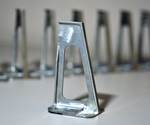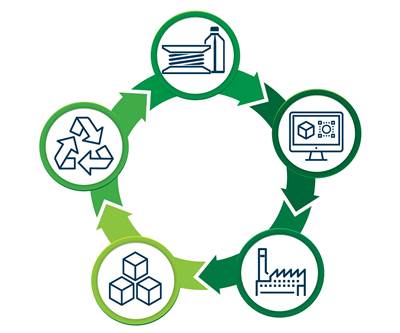The circular economy entails a mode of production aimed at resource conservation. Could it also be a key to national security?
The U.S. Department of Defense believes so. Through its Defense Logistics Agency, the DoD is funding research with metal provider 6K aimed at achieving an entirely domestic supply base for additive manufacturing (AM) metal powder in nickel- and titanium-based aerospace alloys crucial to defense. Material recapture consistent with a circular-economy framework for production will be at the heart of this.
The term “circular economy” is generally associated with sustainability. With material reclaimed rather than going to waste, end-of-life products provide material for future production. But this same idea can also dramatically increase the material available to the DoD within U.S. borders. 6K’s capabilities offer the chance to not just recycle end-of-life components made of aerospace alloys, but also “upcycle” the metal into AM powder, a higher-value form, making possible the domestic supply of this raw material.

6K’s propriety process for making AM powder employs microwave plasma furnaces such as this one at its Pittsburgh plant. Photo credit: 6K
Today, nickel- and titanium-based alloys used in aircraft and other military hardware are made from raw materials that are often imported. The result is a potential point of vulnerability during a conflict. For example, a 2020 White House memorandum noted the vulnerability resulting from U.S. reliance on foreign suppliers for the form of titanium that goes into making titanium alloys.
The good news is this: The U.S. theoretically already has sufficient amounts of these crucial alloys. It is just that the material is not in the right form. It exists as machining scrap, or, more notably, as unused components in aircraft boneyards.

“Upcycling,” for 6K, means converting existing parts and scrap in titanium and nickel alloys into a form like this: precisely spherical powder suitable for AM. This microscopic view shows Inconel 718 powder. Photo credit: 6K
Enter 6K. The company has proprietary technology for converting metal scrap and parts into powder. Indeed, once the convertion gets rolling and end-of-life titanium- and nickel-alloy parts and scrap can keep on being reclaimed, the result could be an infinite supply of this raw material.
That promise is how 6K CEO Aaron Bent, Ph.D., and chief marketing officer Bruce Bradshaw characterized the possibility to me in a conversation about the DoD work. Typical recycling of metal isn’t circular; it’s a downward spiral. The scrap is recaptured in lower-value forms than the original. Truly upcycling aerospace alloy scrap and parts into AM powder hasn’t been practical before, they say, in part because of the cost-prohibitive necessity to refine the material into an intermediary form to make possible conversion to powder. 6K’s process avoids this step. Raw stock that has merely been mechanically ground into a rough powder can be processed into the precisely spherical powder useful for AM, thanks to 6,000°F microwave plasma furnaces in operation at the company’s Pittsburgh plant. Powder for metal injection molding (MIM) and powder forging can be made this way as well. The Defense Logistics Agency’s current funding consists of a Phase II Small Business Innovation Research (SBIR) program to “support the development and commercial supply chain” for these powders, 6K says.

The company’s process is cost-effective for converting existing parts into powder because the intermediary step is relatively easy. Scrap and parts are mechanically ground into rough powder like this.
Bent notes keeping the supply domestic and thereby protecting against disruption are not the only benefits. Sourcing the metal powder via recapture will improve cost and quality as well.
He says, “Material purchased from foreign providers potentially comes with unknowns — unexpected performance anomalies.” This is controllable within a purely domestic closed loop. “Using certified scrap as raw material ensures the raw stock already meets desired specifications. Powders made from this scrap will leverage the investment the DoD has already made in assuring the material’s quality.”
Related Content
Alquist 3D Looks Toward a Carbon-Sequestering Future with 3D Printed Infrastructure
The Colorado startup aims to reduce the carbon footprint of new buildings, homes and city infrastructure with robotic 3D printing and a specialized geopolymer material.
Read MoreMachine Tool Drawbar Made With Additive Manufacturing Saves DMG MORI 90% Lead Time and 67% CO2 Emission
A new production process for the multimetal drawbar replaces an outsourced plating step with directed energy deposition, performing this DED along with roughing, finishing and grinding on a single machine.
Read MoreSustainable Furniture Company Model No. Maintains Product Focus with Switch from DIY to Industrial 3D Printers
The startup founded in 2018 has matured in its product offerings as well as its manufacturing equipment, moving from homegrown 3D printers to industrial large-format machines.
Read MoreEvaluating the Printability and Mechanical Properties of LFAM Regrind
A study conducted by SABIC and Local Motors identified potential for the reuse of scrap reinforced polymer from large-format additive manufacturing. As this method increases in popularity, sustainable practices for recycling excess materials is a burgeoning concern.
Read MoreRead Next
6K's Onyx In718 Metal Powder Created from Sustainable Sources
6K’s Onyx In718 premium nickel alloy metal powder is said to be derived from certified chemistry sustainable sources.
Read MoreWhat Is the Role for Additive Manufacturing in Aircraft Structural Components?
Spirit AeroSystems recently began installing the Boeing 787’s first titanium structural component to be made through AM. The part is not critical but also not minor. I spoke with manufacturing leaders at Spirit about the meaning of the part and the way forward for additive in aircraft structures.
Read MoreAdditive Manufacturing Will Aid And Accelerate The Circular Economy
A circular economy links material, design, manufacturing, product and end-of-life in a continuous, sustainable loop. This special report illustrates the roles for 3D printing every step of the way.
Read More





















